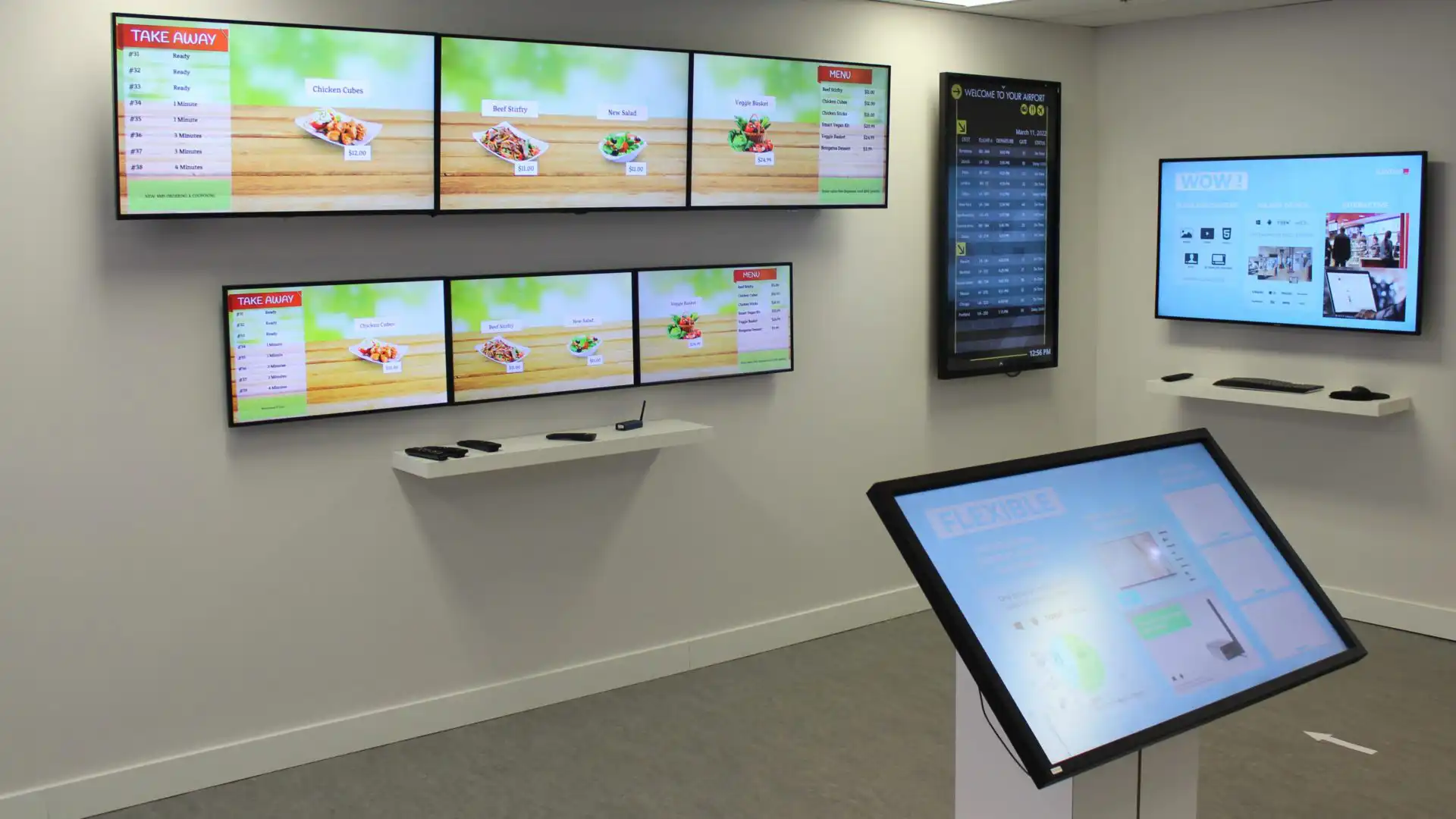The Importance of a Good Digital Signage Content Creation & Strategy
Digital signage is all about content. After all, it’s why people look at your screens. It doesn’t matter if you’re deploying screens in a corporate office, a shopping mall, or a restaurant. Your project will only be as successful as the content you put out.
It’s why you should start every project by establishing a good digital signage content strategy.
Consistency is essential
If you only follow one piece of advice, make it this one. Be consistent.
Consistency makes your message resonate with viewers and promotes engagement. Make sure your digital signage marketing matches your company’s branding and communication style. It doesn’t matter the type of business or the application. There is no excuse for skipping this crucial step.
Consistency brings results. Think of well-known brands like Nike or Disney. A large part of their success is based on a consistent application of their branding and a clear message.
There’s a reason why some companies spend a lot of effort in making sure their brand is always represented in a specific way. Consistency is key to success.
Consistent branding and styling breeds familiarity and helps cement the brand in the mind of consumers. When someone sees a “swoosh” graphic, they instantly know it means Nike. The same goes for the silhouette of mouse ears for Disney.
You don’t need the resources of a Fortune 500 company to implement consistent branding and messaging. You just need to be committed and disciplined.

Who are we?
It begins with your staff. Your collaborative teams should all be on the same page. If you use freelance or third-party resources, give them a design brief or style guidelines so they understand your requirements. They should be familiar with your company’s culture and vision.
What are we trying to say?
Once you have defied your branding and messaging style, it’s time to implement it across different channels (web, social media, digital signage). Your tone should be adapted to the type of activity but the essence of your branding must remain the same. Take for example your branding. You should always enforce the proper use of company logos and other intellectual property across all your communication channels.
Digital signage content strategy
Strive for good quality digital signage content. Quality should be your top priority, especially with digital signage video content. Low-quality video will have a negative impact on viewers’ perception of the brand so it pays to invest in good-quality content.
Your content should be topical, entertaining, and informative. Match the content to the venue to maximize audience engagement. Use good judgment when selecting content for your screens.
Create a digital signage checklist that your team will use when selecting the style and type of content to be published. Make sure the content is relevant to the target audience.
- Corporate communication — Business Intelligence (BI) dashboards, production status, financial news, or employee milestones.
- Digital-out-of-Home — Advertisements and public service announcements.
- Healthcare — Infotainment (news, weather), wait times, health and safety
- Hospitality — Infotainment (news, traffic, weather), airline information, advertisements, and event listings.
- Government — Announcements and events, information, wayfinding.
- Quick-service restaurants — Digital menus, advertising, and promotions.
- Retail — Promotions, branding, product information, wayfinding.
Digital signage advertising tips
Digital signage advertising works much like TV advertising. It’s important to balance ads and information to keep your audience interested. Think of how digital signage is similar to live TV.
On TV, you see a few short ads mixed into the program, so viewers see different ads while watching their favorite shows. Using this same approach with your digital signage can be really effective.
Try adding a few short ads or promotions into your daily content. If you can, change or mix up the ads to keep things fresh. This makes your content more engaging and enjoyable to watch.

Using automation and AI to your advantage
Leverage the “smart” or AI-enhanced features available in your digital signage content management software to save time and create better programming. For example, use content playback rules to screen content based on live events and environmental data.
Computer vision-enhanced digital signage can alter the content shown on the screen based on the demographic profile of the person who’s looking.
Here’s how you can use these technologies to your advantage:
- Screen certain ads based on current weather observations — Ice cream on a hot day.
- Screen ads aimed at viewers of a specific age or gender — Fragrances to women, tools to men.
High-quality content always wins
Everyone knows, “content is king” and it’s even more important when discussing your digital signage content strategy.
Leverage your digital signage content creation tools. Spend the time to learn and master all its features so you can create the best possible content for your screens. Design your content so it’s easily updatable. Whenever possible, also use live data in your layouts to keep your content fresh.
When working with freelance artists and designers, explain how you plan to use the content. Provide them with the target resolutions and screen orientation information so they can produce content that is ready to use without further manipulation.
Always optimize your video files so they are the correct size and format for your screens. Modern video codecs do a great job of producing files that are highly portable while retaining maximum quality. This is important because your content will be stored on a standalone player device that doesn’t have an unlimited capacity.
This is especially important when you are repurposing content that was designed for a different medium.
- Images originally created for print media will probably need to be scaled down and cropped to fit your digital signage screens. Be aware of different color models (CMYK and RGB). Images created for print will use the CMYK color model, while digital signage screens use the RGB model. You may need to convert your images before you can publish them to your screens.
- Videos are mostly shot in landscape (horizontal) screen orientation so you will need to crop or reformat them for portrait (vertical) digital signage screens. You can also shoot your own portrait video using a smartphone. If you do so, make sure the video file format is supported by your digital signage software.
- Video codecs are used to compress the size of your video files. Since video files tend to be quite large, we use codecs to compress them while preserving the on-screen image quality. There are many different codecs so it’s important to know which ones are the most popular and why.

Smart workflows = better results
Your digital signage content management software has all the tools you need to produce quality content. How you use them will dictate the results.
Set up your workflows so team members are most efficient. Eliminate extra steps or production bottlenecks.
- Staff members and freelancers should all be familiar with your branding and style guidelines for consistency and fidelity.
- Prepare and maintain a content specification guide that your team will use when creating or requesting content. This will ensure all content is created and formatted for your screens, eliminating extra manipulation and conversion.
- Use your CMS automation features for efficiency. If your software includes an ad campaign manager, understand how it works and uses it.
- Use content automation like data-driven playback, real-time content triggering, and other similar features.
- Use content validity features to pre-program content ahead of time, or to remove expired content that is no longer relevant. This will automate content presentation.
Recommended Hardware:
For a seamless and captivating digital signage experience, consider the Navori Stix 3700. This powerful media player device is designed to deliver top-notch performance, reliability, and versatility for your signage needs. With its robust construction and advanced features, the Stix 3700 ensures smooth playback of high-definition content, making it perfect for showcasing promotional videos, informational slideshows, and real-time data feeds. Its easy installation and maintenance, along with scalability and expandability, make the Stix 3700 the ideal choice for any digital signage network.
Conclusions
In short, having a clear plan for what you show on your digital signs is really important. It helps businesses grab their audience’s attention, share their brand’s story, and reach their goals. To do this well, businesses need to know their audience, set clear goals, make interesting and relevant content, and keep improving their strategy.
A good plan makes sure the right messages get to the right people at the right time. This makes the digital signs memorable and effective, increasing interest in the brand and leading to success. So, it’s worth putting in the time and effort to make a strong plan for your digital signs. This will make them really work for your business.
About Navori Labs
The Navori Labs Navori digital signage software lets teams be more productive. Navori Content Manager is a user-friendly web-based CMS with built-in automation and content creation tools. It lets team members manage content, create sophisticated templates that use live data feeds, and automate ad campaigns.
Navori also supports multi-level user profiles so internal teams and freelancers can collaborate together on projects, regardless of their responsibilities or physical location.
Interested in learning more? Get in touch with Navori today!
